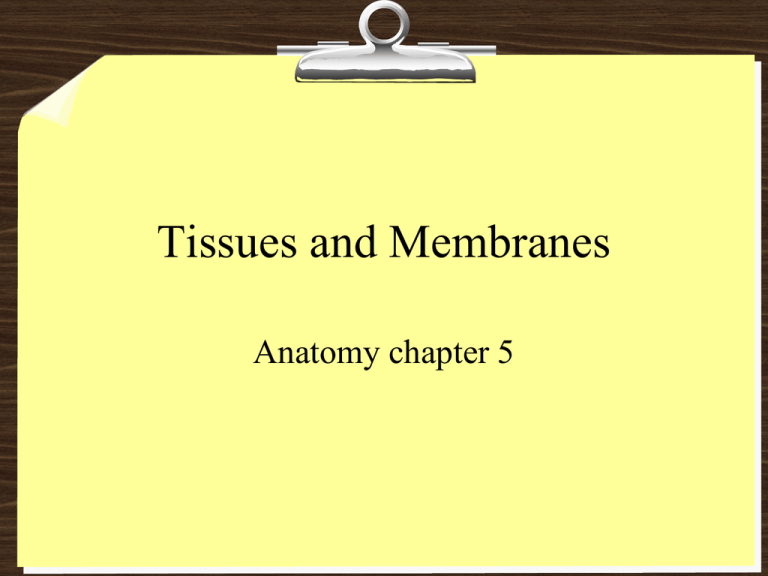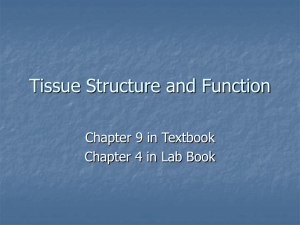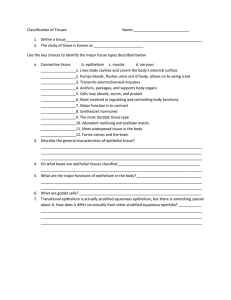Tissues and Membranes
advertisement

Tissues and Membranes Anatomy chapter 5 Body Tissues • A tissue is a group of cells that have similar structures and that function together as a unit. • Histology – the microscopic study of tissues. • There are 4 main tissue types in the body: Epithelial Muscle Connective Nervous Tissue types EPITHELIAL TISSUE Epithelial Tissue • Widespread throughout the body • • • • Cover body surfaces Line body cavities Major tissue in glands It always has a free surface – exposed to the outside or to open space internally • Jobs include protection, secretion, absorption, filtration, diffusion, and sensory reception Epithelial Tissue types Epithelial tissue • Tightly packed cells – very little intercellular matrix (the substance between cells) • Cells are attached to underlying tissue by the basement membrane, which is nonliving. • The basement membrane is a mixture of carbohydrates and proteins. Basement membrane The epithelial cells above receive their nutrients by diffusion from the blood vessels in the underlying tissues. Epithelial tissue • Are avascular – which means they have no blood supply directly. • Reproduce quickly (divide readily) • Are classified according to cell shape and number of layers in the tissue. Epithelial types Squamous cells are flat; the nuclei are broad and thin. Cuboidal – cubelike, the nuclei are spherical and centrally located. Columnar – are tall and narrow, nuclei are usually near the base Simple squamous epithelium • A single layer of thin, flat cells that fit closely together. • Alveoli in lungs • Capillary walls • Tissue is damaged easily. Simple squamous Simple Cuboidal Epithelium • A single layer of cube shaped cells. • Linings of many glands • Lining of kidney tubules • Absorption and secretion Simple Cuboidal Simple Columnar Epithelium • Single layer of cells that are taller than they are wide. • Lining the stomach and intestines, also lines the uterus • Secretes digestive enzymes, absorbs nutrients Simple columnar Simple columnar • Where absorption is necessary, these cells may have microvilli. • Goblet cells secrete mucus. • Cilia may be present Pseudostratified Columnar Epithelium • Appears to have multiple layers, but it really does not. • All cells attached to basement membrane. • Commonly have cilia • Usually in respiratory and male reproductive tract. Pseudostratifed Columnar Stratified Squamous Epithelium • The most common type of layered epithelium. • Many layers of cells. • Cuboidal at the basement membrane, become thinner near the surface. Stratified Squamous Stratified Squamous • Cells at the basement membrane undergo mitosis. • The cells die as they are pushed further from the basement membrane. • Outer layer of skin • As skin cells age, they accumulate keratin (a protein) and then harden and die. Stratified Cuboidal Epithelium • Two or three layers of cuboidal cells that form a lining of the lumen. • More protection than 1 layer. • Lines sweat, salivary and mammary glands, also the pancreas Stratified Columnar Epithelium • Several layers of cells. • Superficial layer are columnar, basal layers are cuboidal. • Found in the pharynx, also in the male urethra. Transitional Epithelium • A specialized type of tissue with several layers, but can be stretched in response to tension. • The lining of the bladder is an example. Transitional epithelium Glandular epithelium • Consists of cells that are specialized to produce and secrete substances. • Lies deep (underneath) epithelium that cover and line parts of the body. • Exocrine glands secrete their products onto a free surface via a duct. Types of glandular epithelium • Simple tubular – the ducts have no branches. • The gland and duct merge with no change in diameter. Types of glandular epithelium • Compound acinar • Has branches (compound) • Has sacs (acinar) • This type is also called alveolar Gland classified by mode of secretion • Merocrine glands – use exocytosis, no cytoplasm is lost. Example: salivary glands • Apocrine glands – Product accumulates in an area of the gland, then is pinched off – a small portion of the cell is lost. Example: sweat glands • Holocrine – the entire cell ruptures, releasing products. Example: Oil (sebaceous) glands CONNECTIVE TISSUE Connective tissue • Binds structures together • Form a framework and support for organs and the body. • Store fat • Transport substances • Protect against disease and repair tissue damage. Connective tissue • Cells can reproduce, but not as quickly as epithelial tissue. • Three types of fibers embedded in intercellular matrix – collagenous fibers, elastic fibers and reticular fibers. • Many cell types in connective tissue. Most common are mast cells, macrophages, and fibroblasts Connective tissue cells • Fibroblasts – Most common. Large cells secrete proteins into the extracellular matrix. • Macrophages – Originate as white blood cells and carry on phagocytosis. Can move about • Mast Cells – Large cells usually near blood vessels. They release heparin and histamine. Fibers • Collagenous fibers – thick threads of the protein collagen. Grouped in bundles. Flexible but only slightly elastic. Important parts of ligaments and tendons. • Elastic – composed of the protein elastin. Weaker than collagenous, but stretch easily. Vocal cords. • Reticular – Very thin collagenous fibers. Highly branched and form a supporting network in organs like the spleen Types of connective tissue • • • • • • • Loose connective tissue Adipose tissue Elastic connective tissue Dense fibrous connective tissue Cartilage Bone Blood Loose connective tissue Loose connective tissue • Also called areolar CT • Packing material in the body • Attaches skin to underlying tissue, fills spaces between muscles. Adipose tissue • Better known as fat • Cells can take up fat and release it at a later date. • Acts as a cushion for the body, insulator for heat. Reticular connective tissue Dense Fibrous Connective Tissue • Closely packed parallel bundles of collagenous fibers. • Make up tendons and ligaments Elastic Connective Tissue • Closely packed elastic fibers. • Yields easily to pulling force. • Vocal cords and vertebral ligaments Cartilage • • • • Has an abundant matrix – solid, yet flexible Cartilage cells are called chondrocytes Heals slowly – no direct blood supply Protects underlying tissues, supports structures, and is a framework 3 types: hyaline, fibrocartilage, and elastic Hyaline cartilage Hyaline: most common type Found at the end of long bones Most of the fetal skeleton is made of this before it is replaced by bone Fibrocartilage • Abundance of strong collagenous fibers. • Acts as shock absorber • Found in between vertebrae and between the bones in the knee joint. Elastic Cartilage • Much more flexible than hyaline or fibrocartilage. • Found in outer ear. Bone • Most rigid connective tissue • Arranged in concentric rings • Form a framework for body, and attach muscles Bone tissue Blood • • • • • Unique because it has a liquid matrix. Erythrocytes – red blood cells Leukocytes – white blood cells Plasma – liquid matrix Platelets – fragment of a cell in the bone marrow. Blood Blood components • • • • Red blood cells White blood cells Platelets Plasma – plasma is 95% water • Other 5% is salts, nutrients, hormones, and proteins. Web sites • Goto http://msjensen.cehd.umn.edu/default.asp • Click on image bank and review some images of types of tissue • Click on self-test and choose a test to take. Use your notes and identify tissue types and structures. MUSCLE TISSUE Muscle Tissue • Made up of cells that have an ability to shorten or contract to produce movement. • Highly cellular – good blood supply • Arranged usually in bundles or layers. • 3 types: skeletal, cardiac, and smooth Types of muscle tissue Skeletal muscle • What we usually think of as “muscle” • 40% of body weight • Fibers are long and cylindrical with many nuclei • Cell has a striated appearance. Skeletal muscle • Muscle fibers are collected into bundles and wrapped in connective tissue. • Skeletal muscle is voluntary Smooth muscle • Found in the walls of hollow body organs – stomach, intestines, etc. • Lacks striations • Also called involuntary muscle Cardiac muscle • Found only in the heart wall. • Look similar to striated muscle • One nucleus per cell • Involuntary contraction NERVOUS TISSUE Nervous tissue • Found in brain, spinal cord and nerves • Responsible for coordinating and controlling body activities. • Communicates by way of electrical nerve impulses. • Nerve cells - neurons Neurons INFLAMMATION AND TISSUE REPAIR Inflammation • A defense mechanism that attempts to contain tissue injury and prepare for healing. • Symptoms: redness, swelling, heat, pain. • It is a beneficial process, even though it may be painful. Inflammatory process • Blood vessels dilate, become more permeable • Increased blood flow to area • Fluid and WBC’s leave vessels and go into tissue space. WBCs engulf debris and bacteria. • Fluid dilutes toxins and contains clotting proteins. Tissue Repair Regeneration Fibrosis • Replacement of destroyed tissue by proliferation of identical cells. • Occurs only in tissues that can undergo mitosis • Skeletal muscle, cardiac muscle, and nerve tissue cannot regenerate. • Replacement of destroyed tissue by fibrous (scar) tissue • Collagen fibers form the basis of the scar. • Immature scar tissue is called granulation tissue. • Scar may be visible or not depending on the severity of the wound. BODY MEMBRANES Body Membranes • Thin sheets of tissue that cover the body, line body cavities, cover organs, and line the cavities in hollow organs. • Skin is a membrane • Membranes may be epithelial or connective tissue. Epithelial membranes Mucous membranes Serous membranes • Epithelial tissue that is attached to loose connective tissue. • Line the body cavities that open to the outside • Examples: digestive tract, respiratory, excretory, and reproductive tracts. • Line body cavities that do not open directly to the outside. • Thin layer of loose connective tissue covered by a layer of simple squamous epithelium. • Covered by a thin layer of serous fluid. Mucous membranes Serous membranes Connective tissue membranes Synovial membranes Meninges • Line the cavities of the freely moveable joints, like the shoulder, elbow and knee. • They secrete synovial fluid into the joint cavity, which lubricates the cartilage. • Connective tissue coverings around the brain and spinal cord. • Provide protection. • Meningitis is inflammation of the meninges. Synovial membranes Meninges Meninges Cell communication • Interactions between cells are vital to the function of other cells, tissues, and organs. • All cells are signaled to survive and carry out homeostasis (maintenance of a constant internal state). • All cells need energy to carry out functions. Methods of cell communication • Most common way that cells communicate is by chemical means. • Hormones • Signal receptors (like a lock and key) • Proteins Specific examples of hormone communication • • • • Cell division Immune response Production of enzymes or proteins Blood clotting Other methods of cell communication • Cell to cell contact • Electrical impulses (SA node in the heart, axons in the nervous system)







